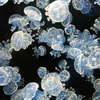Lab 4 Prokaryotes PDF
Document Details

Uploaded by RapturousGyrolite5789
Tags
Related
Summary
This document provides an overview of prokaryotes, including bacteria and archaea. It details general characteristics, different types of bacteria, and their roles in various contexts, including antibiotic resistance.
Full Transcript
prokaryotes OVERVIEW OF PROKARYOTES prokaryotes are found in bacteria and archaea domains general characteristics no nucleus or membrane bound organelles circular, single DNA reproduce asexually...
prokaryotes OVERVIEW OF PROKARYOTES prokaryotes are found in bacteria and archaea domains general characteristics no nucleus or membrane bound organelles circular, single DNA reproduce asexually using binary fission microscopic and single celled cell wall BACTERIA heterotrophs: gain energy from consuming other organic molecules usually are decomposers autotrophs: using light or chemical energy to form organic molecules 3 main types of shape 1. bacili 2. cocci prokaryotes 1 3. spirilli ways bacteria are helpful to humans 1. decomposers 2. undergo fermentation of goods 3. source of biotechnology 4. compose microbiomes of many animals 5. capable of nitrogen fixation antibiotics can be used to destroy bacteria disrupts the peptidoglycan cell wall two types of cell walls 1. gram positive: peptidoglycan cell wall is exposed to external environment 2. gram negative: cell wall is protected by an outer membrane antibiotic resistance: adaptations in bacteria that decrease antibiotic effectiveness antiseptics/disinfectants: antimicrobial substances that damage or kill a range of microorganisms effectiveness can be tested on a plates zone inhibition displays a dead zone (no microorganism survives); larger the better EXPOSURE PLATE ANALYSIS 3 types of growth mold - large, fuzzy with different rings of color yeast - can be smooth or wrinkled with lighter colors prokaryotes 2 bacteria - small, smooth, domed in various colors CYANOBACTERIA cyanobacteria: group of autotrophic bacteria capable of photosynthesis, utilizing photosynthetic pigments pigments include chlorophyll, phycocyanin larger than heterotrophic bacteria forms long filaments of many cells surrounded by a gelatinous layer that makes them slimy gives mobility can photosynthesize and do nitrogen fixation examined Oscillatoria & Anabaena prokaryotes 3 vegetative cells: sites of photosynthesis heterocysts: sites of nitrogen fixation adds support for floatation spores: reproduction sites ANABAENA - has both heterocysts and OSCILLATORIA - lacks heterocysts; vegatative cells fixes nitrogen when oxygen levels are low (temporal separation) ARCHAEA most closely resemble early forms of life most exist in extreme conditions (extremophiles) name where are they found thermophiles extremely hot environments psychrophiles extremely cold environments acidophiles acidic environments alkaliphiles alkaline environments halophiles salty environments methanogens anaerobic (absence of oxygen); prokaryotes 4 releases methane archaean cell walls do not contain peptidoglycan; cell membranes are different composition from phospholipid bilayer in prokaryotes & eukaryotes so far, archaea are non pathogenic PROTIST OVERVIEW protist: refers to eukaryotic organism that are not plants, animals, or fungi difficult to categorize, but in this class they are divivded up into four groups defining category specimens examined traits/characteristics grooves are present on one side multiflagellated found in anaerobic trichonympha, euglena excavata environments (photosynthetic) reduced mitochondria parasitic, predatory, photosynthetic SAR contains phytoplankton stramenophiles (basis of marine food chain) diatoms, golden large & multicellular or algae, brown algae single celled most form hard, shell exterior alveolates can be autotrophs or heterotrophs dinoflagellates, plasmodium vivax, prokaryotes 5 defining category specimens examined traits/characteristics paramecium rhizarians radiolarians, forams organisms are known to photosynthesize using archaeplastida spirogyra various photosynthetic pigments group that includes animals & fungi unikonta amoeba divided into amoebozoans and opisthokonts EXCAVATA TRICHONYMPHA found in termites breaks down cellulose for termites; gets food & shelter symbiotic relationship EUGLENA prokaryotes 6 flagella is located on the anterior (front) contains chloroplasts for photosynthesis eye spot is used for detecting light SAR STRAMENOPHILES mainly photosynthetic with long hairy & smooth short flagella includes diatoms, golden algae, brown algae ALVEOLATES prokaryotes 7 shares membranous sacs at plasma membrane mix of heterotrophs and autotrophs plankton, parasites, and predatory members RHIZARIANS protists with long think pseudopodia (fake feet) & porous shell ARCHAEPLASTIDA possess plastids used in photosynthesis originated from endosymbiosis of a cyanobacterium organisms vary in color example - red algae (rhodophyte) & green algae (chlorophyte) prokaryotes 8 SPIROGYRA contains chloroplasts in a filament structure cross pattern that creates spirals best pattern to maximize light collection spirogyra’s plastids, size, nucleus separates it from other cyanobacteria UNIKONTA includes both animals and fungi amoebozoans: traditional large/wide pseudopodia opisthokonts: organisms that synthesize extracellular chitin, cyst/spore wall, or cell wall AMOEBA has a nucleus, pseudopod, cell membrane prokaryotes 9 moves in direction of the pseudopod towards food eats bacteria, algae, other protozoa prokaryotes 10